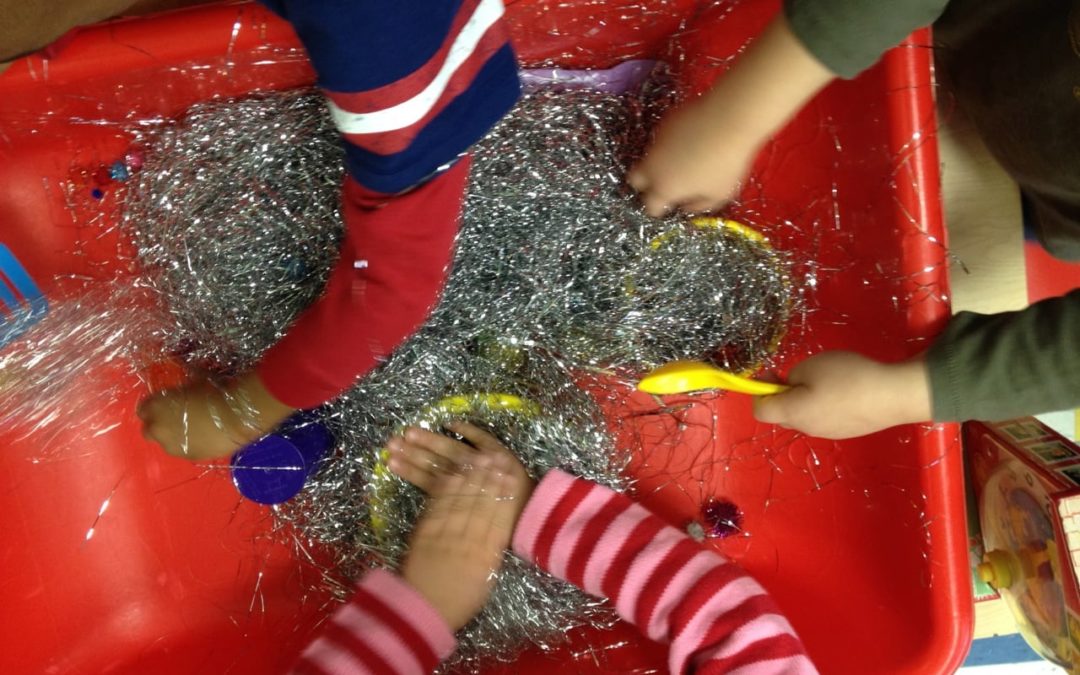By Kelly Gunzenhauser
When my kids were younger, I needed to keep them busy one day, so I dumped their big Legos into a water table and poured water over them. I set it outside the kitchen door where I could work but still keep an eye on them. It doesn’t sound like much, but to them it was fascinating! They built big towers and poured water over them for at least an hour.
I didn’t know it then, but I had created a sensory bin. Sensory bins and tables have always been a go-to for preschool teachers. They are usually filled with rice, beans, sand, or water, along with a few scoops for playing in the loose material. These days, sensory bins and tables are everywhere on the Internet, and they aren’t just for preschool any more. Just do a search for them on Pinterest. You’ll see what I mean.
So, what is a sensory bin and why are they so popular? Simply, a sensory bin—or table—is a low-sided, plastic container filled with items that are fun to look at, smell, touch, and listen to. Most bins are filled with one small material, like rice, beans, pasta, gravel, sand, or water, and may have other play objects added to them. But while the simple ones are still fun and can be very soothing, online sharing has turned sensory bins into an art form. You can make them pirate-themed, or Frozen-themed, or rainbow-themed, or construction-themed, or even holiday-themed! This flexibility is one key to their popularity: you can make them anything you want that captures your child’s interest. Here at Christmas, I have created a sparkly tinsel bin. It’s irresistible to the eyes, and the inevitable static cling makes it interesting in a science-y way: “Why do these silver strands stick to me?”
Another reason so many teachers and parents are making sensory tables and bins now is because they mimic some of the fun free-play in nature we had as children. Sure, our citified kids may not be outside all day, unsupervised and digging in the dirt, but toss a sensory bin in front of them and they can experience undirected, unstructured play with a lot of cool materials. It is in no way a substitute for nature, but it feels similar, somehow, to touch all of those textures and decide what to do with the goodies in the box. Different kinds of kids approach sensory bins in totally different ways.
A sensory bin is a great way to occupy your child while you get something else done nearby. Some children are able to focus closely on the play experience a sensory bin provides. Even familiar toys, like the Legos we had, take on a new life when combined with a different material and contained in a defined space, like a plastic bin. So during this time off from school, think about creating a sensory bin in your house, and let the exploration begin!
*Caution: You MUST supervise children with sensory bins, especially those under age 4 or those who are still mouthing objects at any age. Especially do not leave children unsupervised if you use water in your bin. A young child can drown in only a couple of inches of water.
Here are some Pinterest resources to help you build your own fun sensory bins.
https://www.pinterest.com/gmptfitness/40-sensory-bin-fillers/
https://www.pinterest.com/Maycimae/sensory-bin-fillers/
https://www.pinterest.com/buckeyeshoops/preschool-sensory-bin-ideas/
















